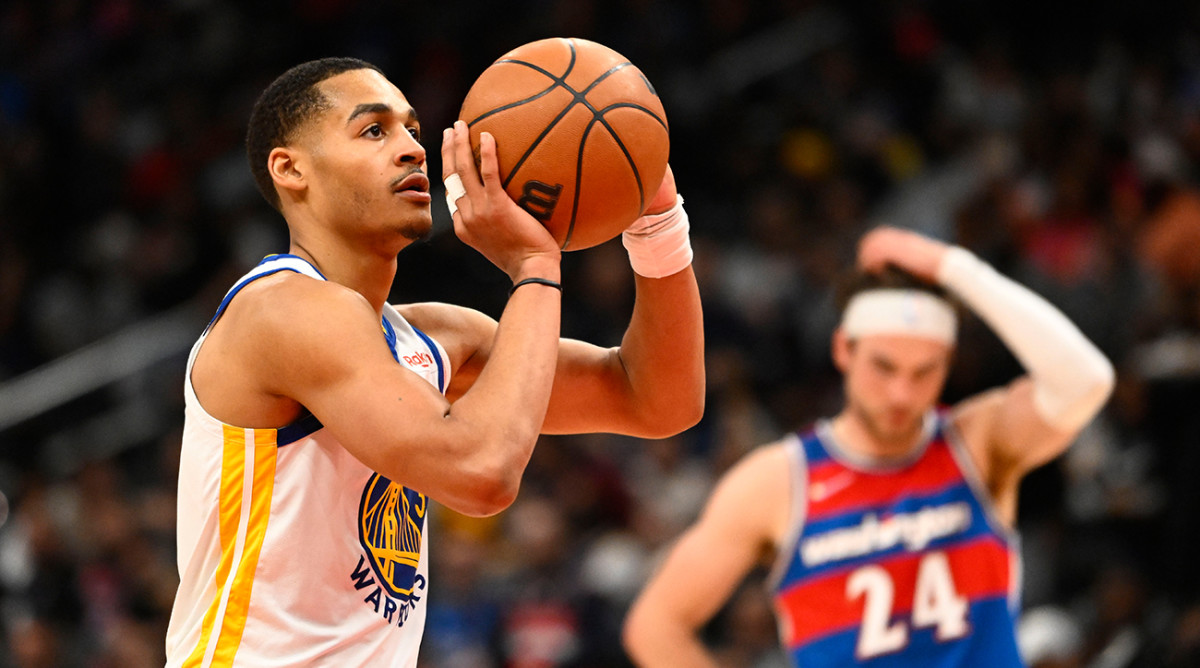Jordan Poole Has to Be the Guy in Washington Now

One thing worth watching this season is how Jordan Poole, the 24-year-old former Warriors sixth man and high-scoring spark plug, will adjust to being a franchise player in Washington.
The betting markets seem to have him pegged as the front-runner for next year’s Most Improved Player award, even though he’ll have the added weight of running an offense without the assistance of future Hall of Famers Stephen Curry, Klay Thompson and Draymond Green, who quietly serves as one of the best screeners and setup men in basketball.
Instead, Poole, once dubbed a third Splash Brother, will now play alongside Tyus Jones and Kyle Kuzma, solid veteran players who will make life easier for him in a handful of ways, but still ones who are a far cry from demanding the sort of defensive attention paid to someone like Curry. (Damian Lillard might be the superstar closest to demanding the sort of full-court pickup Curry prompts.) Bradley Beal and Kristaps Porziņģis are gone now—to Phoenix and Boston, respectively—so it raises the question of how successful Poole will be as a lead option.

Even when Poole had the star talent in Golden State, he often committed unforced errors. His 252 turnovers were the fourth-most in the NBA last season; only Trae Young (300), Anthony Edwards (259) and Russell Westbrook (255) had more. Similar to someone like Young, who had a stellar perception and reputation as a shooter in the league, Poole struggled a bit from outside, hitting just 33.6% of his tries from three last season—the lowest connection rate of the 15 NBA players who launched at least 550 attempts. He shot just a touch under 40% from the 16-to-23-foot midrange portion of the floor—down from 43.1% the season before—but did bolster his overall efficiency by getting to the line more than ever and converted 87% of his free throws and a season-high six times per contest.
It’s challenging to say how much the Warriors—who last fall handed Poole a four-year, $140 million extension that currently looks more than a bit steep—will miss Poole’s playmaking. In exchange, they got future Hall of Famer Chris Paul, who is an interesting addition, because of the narrative (he’s yet to win a ring and is now teaming up with a club that was once his archnemesis) and because his play style runs counter to the Warriors’ in a number of ways. The Dubs love to run, but Paul, once a member of Lob City but now a 38-year-old, has been a bit more deliberate in recent years. He serves as more of a pick-and-roll specialist but is going to a club that uses far less screen-and-rolls than most teams in the league do.
From a turnover standpoint alone, Golden State could see its fortunes improve if Paul can stay healthy (Poole didn’t miss a game last season) and find a convenient fit within the Warriors’ attack. It’s unclear yet whether Paul would be a starter or a reserve with the Warriors, who dominated when last year’s starting five of Curry, Thompson, Green, Andrew Wiggins and Kevon Looney were on the floor. But there were plenty of indications that there were better fits for Poole’s skill set now and potentially long term. After all, Curry, Thompson and Green beat opponents by 15.1 points per 100 possessions (over 720 minutes) when they were on the floor together last season. That same trio, alongside Poole, turned out to be lethargic, getting beaten by 5.1 points per 100 possessions (almost 370 minutes), when Steve Kerr test-drove the foursome. When Poole was on the court without any of those three teammates, the Warriors got beaten by about the same amount: roughly 5.4 points per 100 possessions over 511 minutes.
With what we all assume will be a green light, it will be fascinating to see what level of discipline—as a scorer and passer—Poole comes back with. It’d be great if he makes the leap to scoring 25 points per night, but would he be doing so in an efficient, team-friendly way? If the Wizards, as we’re all expecting, turn out to be closer to a rebuilding team, how will Poole approach the idea of defense? The notion has largely eluded him in recent years but is the sort of thing that becomes wildly important when you’re the face of a team. Wes Unseld Jr., who was rumored to be on the hot seat at times last season, shouldn’t hold back when coaching Poole—particularly as a defender—and tapping into the remaining potential he’s yet to realize.
Team president Michael Winger and the Wizards were incredibly quick about turning the page by unloading Beal and Porziņģis, even without getting enormous returns. In part because of that, the organization needs to pour everything it has into making sure the crafty Poole develops into more on both ends of the floor. That may not be an easy process, but depending on the approach he takes to being in the driver’s seat, the Wizards may have a great opportunity to step into the future, feeling optimistic about these new beginnings.
